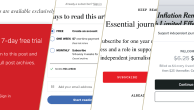About This Study
The primary PEJ staff members conducting the research, analysis and writing for this report included: Tom Rosenstiel, director; Mark Jurkowitz associate director; and Hong Ji; senior methodologist.
Other staff members who made contributions were Tricia Sartor, weekly news index manager; Dana Page, communications and creative design manager; and Laura Houston Santhanam, research analyst.
Scott Keeter, director of survey research at the Pew Research Center consulted in the design of the questionnaire and in the analysis of the data.
Copy editing was done by Molly Rohal, communications coordinator for the Pew Research Center.
The Survey and Interview Process
This effort to examine the newspaper industry’s search for a new business model involved several layers of reporting and several different research instruments over a period of 16 months. That began with a series of discussions with a dozen major newspaper companies that started in late 2010. Ultimately, six companies representing 121 papers agreed to share detailed information from individual newspapers.
In the spring and summer of 2011, there were site visits to conduct lengthy interviews with executives at those companies in order to get their input about how to gather that data. Based on those meetings, the Project for Excellence in Journalism, in conjunction with Princeton Survey Research Associates International, developed 60 questions or data categories for each paper to fill out relating primarily to digital advertising. Thirty-eight newspapers at those six companies, representing about one-third of their properties, provided the data with the understanding that it would be “anonymized,” meaning that no papers or companies would be named in our reports. The study did not ask about digital subscriptions or paywalls, leaving that for the future, because the number of papers that have moved in that direction is still small and, in many cases, not enough time has elapsed to draw conclusions.
Once researchers analyzed the data, we conducted follow-up interviews in January and February 2012 with executives at the six participating companies and at seven additional newspaper companies. Those 13 companies-nine private and four public-comprise 330 daily papers, or 24% of the U.S. daily English-language papers currently in existence. We shared the findings with those executives, asked whether the data reflected what was happening throughout their companies and what the numbers said about where the industry is now and where it is heading.
The Newspaper Sample
The vast majority of daily papers in the United States are small,with circulations under 25,000, something that is reflected in our sample. Of the papers that provided detailed data, 22 have circulations under 25,000, seven have circulations between 25,000 and 50,000, and nine have circulations of 50,000 or more (including three with circulations more than 100,000).
The sample of papers that provided detailed data also was geographically spread across the country. Eight papers are located in the West, eight in the Midwest and 16 across the South, from Florida to Texas. Six more are from the Northeast. Nineteen of the papers were published in communities with a population of less than 50,000, 12 of them came from communities with a population between 50,000 and 100,000 and seven originated in cities with populations more than 100,000.
The sample was selected to reflect the variety of sizes and types of newspapers, but is not a scientific sample and it is not possible to compute a margin of error.
Web Survey Methodology
This report is based on responses from 38 U.S. daily newspapers recruited by the Pew Research Center’s Project for Excellence in Journalism (PEJ). The survey was administered online in English by Princeton Survey Research Associates International (PSRAI). The surveys were completed from October 26, 2011 through February 15, 2012.
Requests for participation were sent via e-mail to corporate news executives who then forwarded the email invitation to the appropriate manager at their company’s daily newspapers. Email invitations contained a link to an online web address where the survey was hosted by PSRAI. Each daily newspaper had a unique identification code with which the participants) could log in to the survey.
Corporate newspaper executives were first emailed on October 19, 2011, explaining the study and requesting their cooperation in contacting the appropriate advertising manager(s) at their individual daily newspapers. Emails included a link to the online survey as well as a list of unique passwords, one per daily newspaper, to gain entry into the web instrument. To encourage participation in the study, follow-up emails were sent and phone calls were made periodically throughout the field period to those who did not already complete the survey or did not refuse to participate.
Calculating the Averages
In order to calculate the overall rates of decline and growth in digital and print ad revenues, PEJ asked the participating companies to provide us with their print ad revenue and digital ad revenue in both 2009 and 2010. We added the total number of advertising dollars from each participating newspaper that provided data for both years and divided by the number of these newspapers. Based on these overall numbers in each year, we calculated the rate of annual digital ad revenue change and annual print change over time.
In order to ease the impact that larger daily papers have had on the totals, we also gauged newspaper economics another way, by calculating the average percentage gain or loss in print and digital ad revenue for each individual paper and then taking the average of those changes.
In order to determine the percentage of overall digital revenue coming from different advertising modes, we asked the participating papers to provide us with data from the most recent quarter for which they had information in 2011 and from the same quarter in 2010. We analyzed the digital ad revenue coming from display and banner advertising, digital classified advertising, smart targeted advertising, video advertising, and daily deals/discount Coupon programs. For each mode, the overall percentage of digital ad revenue across papers was calculated by adding the percentage of digital ad revenue from each participating newspaper that provided data for both years and dividing by the number of these papers.




